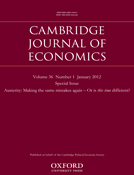-
Views
-
Cite
Cite
Robert H. Wade, Silla Sigurgeirsdottir, Iceland’s rise, fall, stabilisation and beyond, Cambridge Journal of Economics, Volume 36, Issue 1, January 2012, Pages 127–144, https://doi.org/10.1093/cje/ber038
Close - Share Icon Share
Abstract
Iceland is an unusually pure example of the dynamics that blocked regulation and caused financial fragility across the developed world for 20 years. This essay describes the statist-and-corporatist political economy of the country as it soared from near the bottom of the Western European income hierarchy at the end of the World War II to up near the top by the 1980s. It illustrates how a group of neoliberal politicians and allied civil servants drove through selective deregulation and privatisation in the 1990s and 2000s. In the space created for newly privatised banks, Icelandic financiers grew the banks and linked private equity firms through mergers and acquisitions abroad to the point where by 2007 tiny Iceland supported three banks in the world’s biggest 300 banks, with assets eight times the GDP—second highest in the world after Switzerland. As profits from these overseas operations were partly redistributed back to Iceland the economy boomed, in the grip of super-Minsky processes. The government, the banks and the media interpreted the boom as testimony to the validity of neoliberal policies and went out of their way to hide increasing financial fragility from view, preventing a negative or self-correcting policy feedback loop. The accident waiting to happen happened in the wake of the Lehman collapse in September 2008. The essay charts the zigzags of the government’s response and the citizens’ response, and discusses the prospects for a resumption of growth on a more sustainable basis. It suggests that Iceland illustrates in miniature the ratcheting down of mass living standards underway across the Western world now that the cushion of debt has been removed, even as financiers and others in the top few percentiles of national income distributions increase their share of national income. But economic institutions and politics matter: in Iceland the large devaluation spread the cut in a relatively ‘apolitical’ way; the government let the banks go bust rather than bail them out at taxpayers’ expense; it imposed capital controls on outflows; and it used fiscal transfers to protect the bottom half of the population from disproportionate cuts.




